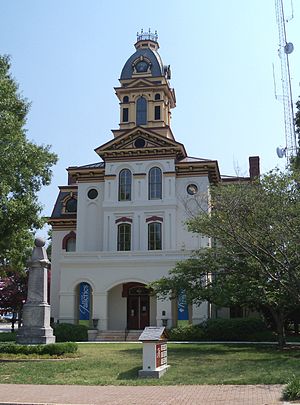Cabarrus County | |
|---|---|
 | |
| Motto: "America Thrives Here" | |
 Location within the U.S. state of North Carolina | |
 North Carolina's location within the U.S. | |
| Coordinates: 35°23′N 80°33′W / 35.39°N 80.55°W | |
| Country | |
| State | |
| Founded | 1792 |
| Named for | Stephen Cabarrus |
| Seat | Concord |
| Largest community | Concord |
| Area | |
• Total | 363.93 sq mi (942.6 km2) |
| • Land | 361.23 sq mi (935.6 km2) |
| • Water | 2.70 sq mi (7.0 km2) 0.74% |
| Population (2020) | |
• Total | 225,804 |
• Estimate (2023) | 240,016 |
| • Density | 625.10/sq mi (241.35/km2) |
| Time zone | UTC−5 (Eastern) |
| • Summer (DST) | UTC−4 (EDT) |
| Congressional districts | 8th, 12th |
| Website | www |
Cabarrus County (/kəˈbɛərəs/ kuh-BAIR-us)[1][2] is a county located in the south-central part of the U.S. state of North Carolina. As of the 2020 census, the population was 225,804, making it the 9th-most populous county in North Carolina.[3] The county seat is Concord,[4] which was incorporated in 1803. Cabarrus County is included in the Charlotte-Concord-Gastonia, NC-SC Metropolitan Statistical Area.
The first substantiated gold find in America took place in Cabarrus County in 1799, when Conrad Reed discovered gold in Little Meadow Creek. The Reed Gold Mine (now a National Historic Landmark) was founded, and resulted in a gold rush to the area in the early 1800s.[5] While some cotton plantations were established, most of the land was developed for subsistence farming. By 1860 the population consisted of about one-third enslaved African Americans, with few free people of color. Industrialization had started before the war with the introduction of textile mills to process the cotton. More mill development took place, especially after the railroad was constructed to the town. Coleman Manufacturing Company, started in 1897, is believed to be the first cotton mill in the nation to be built, owned and operated by African Americans. It was owned by Warren Clay Coleman from Concord, John C. Dancy (federal collector of customs), and seven partners primarily from Wilmington, North Carolina. Investors included Washington Duke and capitalists in other parts of the state. Textile manufacturing continued to be integral to the regional economy until the late 20th century. In 2015, the Coleman-Franklin-Cannon Mill was listed on the National Register of Historic Places.
- ^ "NC Pronunciation Guide". WRAL. Retrieved August 16, 2023.
- ^ Talk Like a Tarheel Archived June 22, 2013, at the Wayback Machine, from the North Carolina Collection website at the University of North Carolina at Chapel Hill. Retrieved August 16, 2023.
- ^ Cite error: The named reference
2020CensusQuickFactswas invoked but never defined (see the help page). - ^ "Find a County". National Association of Counties. Archived from the original on May 31, 2011. Retrieved June 7, 2011.
- ^ Midgette, Nancy (November 2001). "Review of Gold Mining in North Carolina: A Bicentennial History by Richard F. Knapp and Brent D. Glass". The Journal of Southern History. 67: 850–851. JSTOR 3070264.

